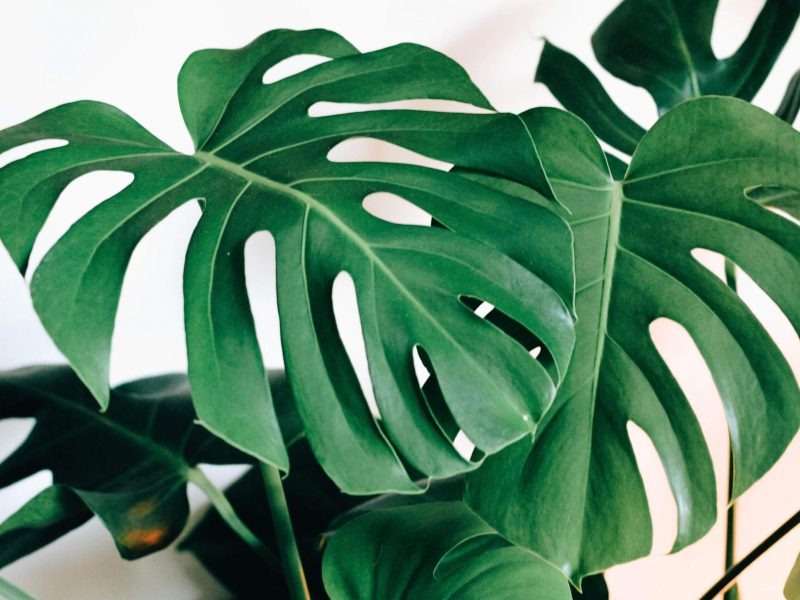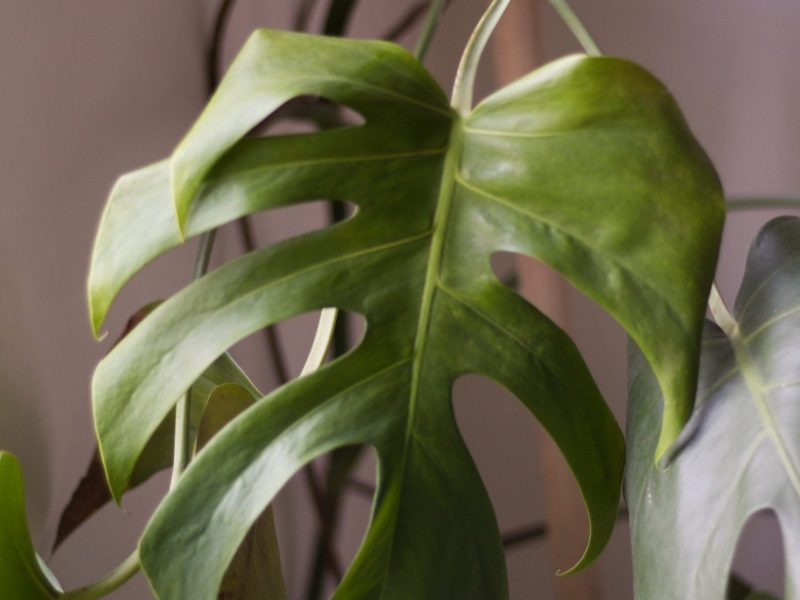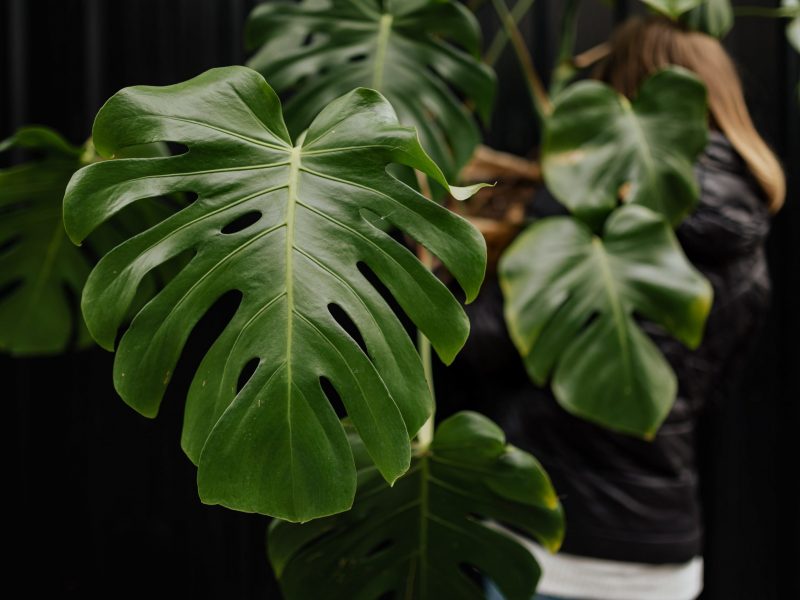
Monstera plants, also known as Swiss Cheese plants, have become very popular over the last decade and we can totally understand why. With their unique split heart-shaped leaves, they instantly become the focus of a room.
However, if your Monstera isn’t in its optical environment or something in the care routine isn’t quite right, you may find that its leaves start to turn brown. This can appear in many forms, either as brown spots, tips and patches or entire leaves turning brown. The difference helps to diagnose the issue so take a good look at how the brown leaves are developing and that can help to give an indication of what the issue is.
In this article, we will be covering all of the most common reasons why Monstera plants develop brown leaves, including watering issues, lighting and humidity problems and also issues with nutrition and fertilizing. We will also give you information on how to diagnose the issue correctly, treat it quickly and prevent it from causing more harm to your Monstera in future.
Common causes of brown leaves on a Monstera
Overwatering your Monstera can cause dark brown spots
If you notice that your Monstera is developing dark brown spots on its leaves, the most common cause of this is overwatering. We tend to go for a little and often approach towards watering with most of our houseplants, and this is especially the case with our Monsteras. They hate their roots sitting in puddles of water, so you need to make sure that you have good drainage setup (perlite in the soil and drainage holes) and don’t give them too much water at once.
Overwatering can very quickly lead to root rot which is extremely harmful. Alongside browning leaves, root rot can also cause the plant to become unstable and have trouble picking up nutrients through its root structure.
If it isn’t caught quickly, it can mean your plant will not be able to survive for very long. If you think you might have overwatered your Monstera it’s important to check the soil moisture right away and change the potting mix out completely if necessary.
Make sure to check the moisture in the soil before you water. The easiest way to check this is by digging your finger into the top two centimetres of the soil to see how damp it is. We also recommend picking up your Monstera before and after watering. This should give you a feel for when your Monstera might need a little more water, simply by giving them a lift and feeling the weight. However, we only recommend this if your Monstera is no bigger than 1/1.5 metre tall as they can get quite heavy quite quickly, so be careful!
If you aren’t really sure about how to know if your Monstera needs watering, we recommend picking up a moisture meter. They are super affordable and tell you how much moisture is in the soil.
Underwatering your Monstera causes light brown crispy edges
If you notice that your Monstera is developing light brown spots or dry crispy edges on the leaves, then it may be that you’re under-watering your plant.
Although Monsteras don’t like sitting in water, they also don’t like their soil being too dry for longer periods of time. The easiest way to tell is again just by checking the moisture in the soil using a moisture meter and adjusting your watering schedule accordingly.
With underwatering, the leaves will turn quite light brown, in contrast to overwatering which causes darker brown patches. These will also start off from the edges and move throughout the leaf afterwards.
Your Monstera could be getting too much direct sunlight
Brown leaves may also be because your Monstera is getting too much direct sunlight. This can cause the leaves to burn, from which they will not be able to recover.
Monsteras do like areas with bright light, but it needs to be indirect. South-facing windows can give your Monstera too much direct light so try moving them to a different window.
You need to also watch out a little more in summer when the sun is a lot stronger for more of the day. It is best to move your Monstera a metre or so further away from the window in warmer months to avoid any leaf burn.
To figure out how much light your Monstera is getting throughout the day, you can use a light meter. It may be that your Monstera is getting a lot of direct sunlight in the morning, or is in too much shade in the afternoon.
Low humidity levels cause brown edges on Monstera leaves
Monsteras prefer a humid environment as they originate from tropical forests. If you find that the edges of your Monstera leaves are turning brown, then it may be because the air in your home is too dry for it.
There are a few really simple techniques to keep the humidity higher than normal for your Monstera; you can spray down the leaves with a mist bottle every few days, sit your plant in a tray with water and some pebbles or put your monstera in the bathroom and leave the shower on hot for 5 minutes.
The best way to consistently increase the humidity for your plant is by using a humidifier. They help to increase the water vapour in the air around your plants and will lead to a lot of happy and healthy plants which will keep the dry leaves away.
You can also pick up a good humidity monitor to keep track of everything if you’re more concerned. Make sure to also move your Monstera away from any air conditioning units as these create very dry air!
There may be a pest infestation
Another rarer cause of brown leaves on a Monstera is a pest infestation. There are a variety of pests including spider mites, mealybugs and scale insects that might make your Monstera their new home.
The issue with a pest infestation is that the pests slowly suck on the leaves, exhausting your plant and causing brown spots and holes across the leaves.
If your Monstera is suffering from a pest infestation don’t think you need to say goodbye to it straight away. If treated properly, you can get rid of the infestation.
Firstly, you should trim off the worst affected leaves and stems to curb the infestation from growing quickly and then begin treating your Monstera with neem oil and an insecticide.
If you have caught the infestation fairly early and are rigorous in your methods to stop it, then you can be successful at getting rid of it. However, pests are a nightmare for plant parents and there does reach a point where you may need to say goodbye to your plant. There is also the risk of the infestation spreading to other houseplants so be wary of that and isolate any infected plants.
Lack of nutrients could be the cause
A less obvious cause of your Monstera’s leaves turning brown is a lack of nutrients. If you haven’t repotted your monstera in new soil in a year or two it is definitely a good idea to swap out some of the soil in the pot with a good rich potting mix or compost.
It is also a good idea to feed your plant every few months in the growing seasons (spring and summer) just to make sure is it getting enough nutrients to grow. You can either use a liquid fertiliser which you dilute into the water, or fertiliser spikes which you pop into the soil and nutrients are released over time.
How to treat brown leaves on a Monstera
Prune any brown leaves away
If the entire leaves have turned brown, then the best thing to do is remove them from your Monstera. They will eventually fall off naturally once completely dead but removing them now means that your plant will focus on developing new, healthy growth.
If some of the leaves only have a small brown patch or a few brown leaf tips here and there, then we don’t recommend moving these. Although you might think that aesthetically it looks better, you don’t want to remove too much of the plant. This will limit its ability to photosynthesise and produce more foliage.
Replace any waterlogged soil
If there are watering issues that have been the cause of the brown leaves on your Monstera, then replace any waterlogged soil immediately. Whilst you may be tempted to wait for the potting mix to naturally dry out over the next few days, this does risk more damage being done to the root system.
By replacing any waterlogged soil straight away, you allow the root system to recover as soon as possible. It’s also a good idea to trim away any rotten roots whilst you’re replacing the soil as once they have turned soft, there is no going back, unfortunately.
Adjust your watering routine
If overwatering or underwatering is causing the brown leaves on your Monstera, then it’s important that you adjust your watering routine. There are two things you can adjust to make sure you are watering your Monstera the right amount; frequency and depth.
If you are overwatering your Monstera then you either want to cut back on the frequency, or not give your Monstera as much water each time. This will allow your Monstera’s potting mix to dry out between waterings.
If you are underwatering you then either want to increase how often your water your plant, or water it more deeply each time.
How to prevent brown leaves on a Monstera
Now that you’ve taken the steps to stop the current issue causing brown leaves on your Monstera, there are a few things you should be doing throughout the year to prevent them. Once part of the leaf has turned brown, there is no returning it to green which is why prevention is crucial.
Monitor soil moisture
Staying on top of your watering habits is will be key to not only preventing brown leaves on your Monstera but also other issues. You want to find the right balance of letting the soil dry out enough to not cause root rot, but watering frequently enough not to dry out your plant.
There will be lots of factors involved in how quickly the soil dries out (light level, temperature, pot size just to name a few), so a rigid watering routine won’t work very well.
Instead, you need to monitor your plant’s moisture and respond to changes in the environment by adjusting your watering routine.
Adjust positioning throughout the year
Another way to prevent brown leaves from developing on your Monstera is to actually move it around throughout the year. If your Monstera is getting too much sunlight in summer where it currently is, then it might need to move to a slightly shadier spot. However, when winter comes that new spot might be too dark and you may need to relocate your Monstera back to the window.
Monitor the environment
Aside from monitoring soil moisture, you should also be keeping tabs on the temperature around your plant. This will help you detect hotspots and cold drafts that might be impacting your plant throughout the year.
Spotting these early will help you to rectify the issue before it’s started to cause brown spots, tips or leaves on your Monstera.
Get into a misting routine
Because they are native to tropical areas, keeping the humidity high is crucial for the long-term health of your Monstera. Getting into the habit of misting your plant several times a week will go a long way to preventing brown leaf tips.
Misting frequently also has the added bonus of helping to remove dust from the leaves (which can be an issue with Monstera plants as they have such large flat leaves). This helps them look fresh and aids photosynthesis too!
Frequently Asked Questions
Still unsure about fixing and preventing brown leaves on your Monstera? Hopefully, these FAQs can help you figure out the next steps needed to solve and avoid the issue.
How do I stop my Monstera from turning brown?
Brown leaves can be caused by a variety of issues with the care routine or environment with watering problems being the most common. Aside from watering correctly, dry air can also cause brown leaf tips on a Monstera as well as temperature issues so monitor the environment closely to stop your plant from developing brown patches on the leaves.
Can brown leaves on my Monstera turn green again?
Unfortunately, once part of the leaf has turned brown there is no going back, no matter what you do. However, the quicker you diagnose and fix the issue the sooner you can prevent even more of your Monstera from turning brown so it’s crucial you figure out what’s causing it.
Do brown leaves mean my Monstera is dying?
Yes, brown leaves on a Monstera do indicate that it is unhappy with either something in its environment or part of the care routine. Watering problems are the most common so we recommend starting by checking the soil moisture and going from there.
How do I fix the brown leaves on my Monstera?
The first thing to do is check the soil to see if you are either underwatering or overwatering your Monstera as these are the most common causes of brown leaves. If this is the cause, then adjust your watering schedule moving forward and replace any waterlogged soil.
If watering issues are not the cause, then check the humidity, temperature and light level around your Monstera.
Should I cut off the brown leaves from my Monstera?
If the entire leaf has turned brown then you should remove it from the plant. This allows your Monstera to focus its energy on producing new healthy (and green) leaves. However, if there are just a few brown spots or tips then this leaf can still be valuable to your plant.
Why does my Monstera have brown spots?
There are several factors that can lead to brown spots on your Monstera including sunburn, a lack of humidity and a pest infestation.
Will the brown leaves on my Monstera recover?
Unfortunately, once any part of your Monstera’s leaf has turned brown, there is no going back, that is permanent. This is why diagnosing and fixing the issue is crucial to avoid more brown leaves from developing.
These are the most common reasons why your Monstera’s leaves may be turning brown. Once the leaf has started to turn brown there is often no going back for that leaf so we recommend pruning the dark parts of the leaf, or removing entirely if the whole leaf has turned brown.
Catching the issue as early as possible will give you the best chance at reviving your Monstera and preventing more brown leaves. This is why we recommend giving your Monstera (and other houseplants) a monthly check-up which gives you the opportunity to inspect your plants and spot any early warning signs.
To learn more about how to keep your plant thriving, check out our Monstera care guide.













